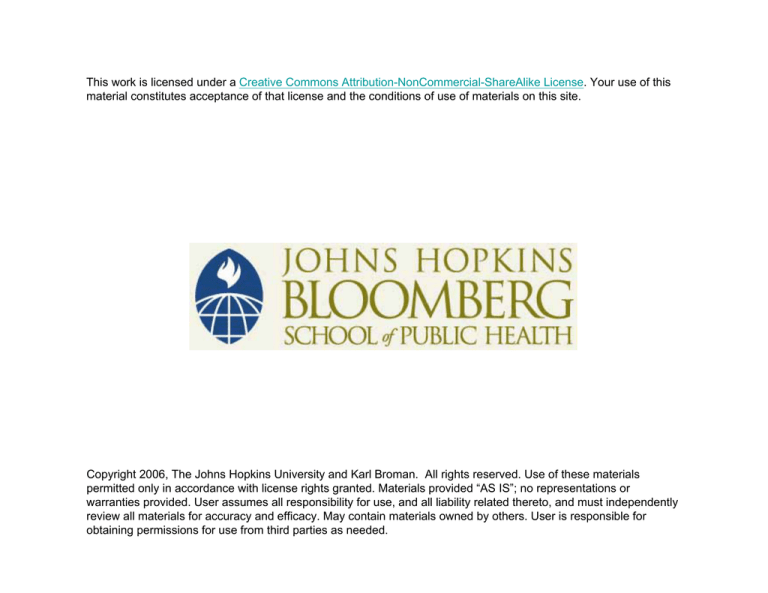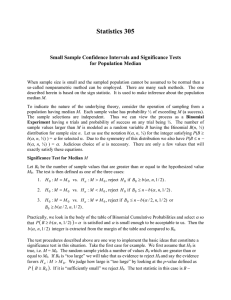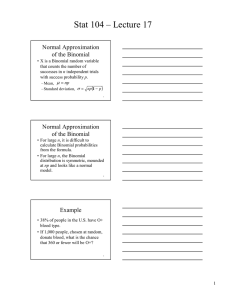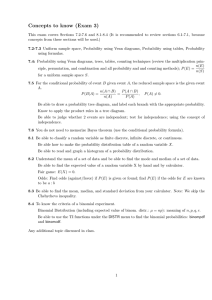
This work is licensed under a Creative Commons Attribution-NonCommercial-ShareAlike License. Your use of this
material constitutes acceptance of that license and the conditions of use of materials on this site.
Copyright 2006, The Johns Hopkins University and Karl Broman. All rights reserved. Use of these materials
permitted only in accordance with license rights granted. Materials provided “AS IS”; no representations or
warranties provided. User assumes all responsibility for use, and all liability related thereto, and must independently
review all materials for accuracy and efficacy. May contain materials owned by others. User is responsible for
obtaining permissions for use from third parties as needed.
Example
[Carroll, J Med Entomol 38:114–117, 2001]
Place tick on clay island surrounded by water, with two capillary
tubes: one treated with deer-gland-substance; one untreated.
Does the tick go to the treated or the untreated tube?
Tick sex
male
female
male
female
male
female
male
female
Leg
fore
fore
fore
fore
hind
hind
hind
hind
Deer sex
female
female
male
male
female
female
male
male
treated untreated
24
5
18
5
23
4
20
4
17
8
25
3
21
6
25
2
Is the tick more likely to go to the treated tube?
Test for a proportion
Suppose X ∼ binomial(n, p).
Test H0 : p =
1
2
vs Ha : p 6=
1
2
Reject H0 if X ≥ H or X ≤ L
Choose H and L such that
Pr(X ≥ H | p = 12 ) ≤ α/2 and Pr(X ≤ L | p = 12 ) ≤ α/2
Thus Pr(Reject H0 | H0 is true) ≤ α.
The difficulty: The binomial distribution is hard to work with. Because of its discrete nature, you can’t get exactly your desired
significance level (α).
Rejection region
Consider X ∼ binomial(n=29, p)
Test of H0 : p =
1
2
vs Ha : p 6=
1
2
at significance level α = 0.05
Lower critical value:
qbinom(0.025, 29, 0.5) = 9
Pr(X ≤ 9) = pbinom(9, 29, 0.5) = 0.031 → L = 8
Upper critical value:
qbinom(0.975, 29, 0.5) = 20
Pr(X ≥ 20) = 1-pbinom(20,29,0.5) = 0.031 → H = 21
Reject H0 if X ≤ 8 or X ≥ 21.
(For testing H0 : p = 21 , H = n – L.)
Binomial(n=29, p=1/2)
1.2%
0
1.2%
5
10
15
20
25
Significance level
Consider X ∼ binomial(n=29, p)
Test of H0 : p =
1
2
vs Ha : p 6=
1
2
at significance level α = 0.05
Reject H0 if X ≤ 8 or X ≥ 21.
Actual significance level:
α = Pr(X ≤ 8 or X ≥ 21 | p = 21 )
= Pr(X ≤ 8 | p = 21 ) + [1 − Pr(X ≤ 20 | p = 21 )]
= pbinom(8,29,0.5) + 1-pbinom(20,29,0.5)
= 0.024
If we used, instead, “Reject H0 if X ≤ 9 or X ≤ 20,” the significance
level would be:
pbinom(9,29,0.5) + 1-pbinom(19,29,0.5) = 0.061
Example
Observe X = 24 (for n = 29)
Reject H0 : p =
1
2
if X ≤ 8 or X ≥ 21.
Thus we reject H0 and conclude that the ticks were more likely to
go to the deer-gland-substance-treated tube.
P-value = 2 × Pr(X ≥ 24 | p = 12 )
= 2 * (1 - pbinom(23, 29, 0.5))
= 5/10,000.
Alternatively: binom.test(24, 29)
Example 2
Observe X = 17 (for n = 25); assume X ∼ binomial(n=25, p)
Test H0 : p =
1
2
vs Ha : p 6=
1
2
Rejection rule: Reject H0 if X ≤ 7 or X ≥ 18
qbinom(0.025, 25, 0.5) = 8
pbinom(8, 25, 0.5) = 0.054
pbinom(7, 25, 0.5) = 0.022
Significance level:
pbinom(7,25,0.5) + 1-pbinom(17,25,0.5) = 0.043
Since we observed X = 17, we fail to reject H0
P-value = 2*(1-pbinom(16,25,0.5)) = 0.11
Confidence interval for a proportion
Suppose X ∼ binomial(n=29, p) and we observe X = 24.
Consider the test of H0 : p = p0 vs Ha : p 6= p0
We reject H0 if
Pr(X ≤ 24 | p = p0) ≤ α/2
or
Pr(X ≥ 24 | p = p0) ≤ α/2
95% confidence interval for p:
The set of p0 for which a two-tailed test of H0 : p = p0 would
not be rejected, for the observed data, with α = 0.05.
The “plausible” values of p.
Example
X ∼ binomial(n=29, p); observe X = 24
Lower bound of 95% confidence interval:
Largest p0 such that Pr(X ≥ 24 | p = p0) ≤ 0.025
Upper bound of 95% confidence interval:
Smallest p0 such that Pr(X ≤ 24 | p = p0) ≤ 0.025
In R:
binom.test(24,29)
95% CI for p: (0.642, 0.942)
Note: p̂ = 24/29 = 0.83 is not the midpoint of the CI
Binomial(n=29, p=0.64)
2.5%
0
5
10
15
20
25
Binomial(n=29, p=0.94)
2.5%
0
5
10
15
20
25
Example 2
X ∼ binomial(n=25, p); observe X = 17
Lower bound of 95% confidence interval:
pL such that 17 is the 97.5 percentile of binomial(n=25, pL)
Upper bound of 95% confidence interval:
pH such that 17 is the 2.5 percentile of binomial(n=25, pH)
In R:
binom.test(17,25)
95% CI for p: (0.465, 0.851)
Again, p̂ = 17/25 = 0.68 is not the midpoint of the CI
Binomial(n=25, p=0.46)
2.5%
0
5
10
15
20
25
20
25
Binomial(n=25, p=0.85)
2.5%
0
5
10
15
The case X = 0
Suppose X ∼ binomial(n, p) and we observe X = 0.
Lower limit of 95% confidence interval for p: 0
Upper limit of 95% confidence interval for p:
pH such that
Pr(X ≤ 0 | p = pH) = 0.025
=⇒ Pr(X = 0 | p = pH) = 0.025
=⇒ (1 − pH)n = 0.025
√
n
=⇒ 1 − pH = 0.025
√
n
=⇒ pH = 1 − 0.025
In the case n = 10 and X = 0, the 95% CI for p is (0, 0.31)
A mad cow example
New York Times, Feb 3, 2004:
The department [of Agriculture] has not changed last year’s plans to test
40,000 cows nationwide this year, out of 30 million slaughtered. Janet Riley,
a spokeswoman for the American Meat Institute, which represents slaughterhouses, called that “plenty sufficient from a statistical standpoint.”
Suppose that the 40,000 cows tested are
chosen at random from the population of 30
million cows, and suppose that 0 (or 1, or 2)
are found to be infected.
How many of the 30 million total cows would
we estimate to be infected?
What is the 95% confidence interval for the
total number of infected cows?
No. infected
Obs’d Est’d
0
1
2
0
750
1500
95% CI
0 – 2763
19 – 4173
181 – 5411
The case X = n
Suppose X ∼ binomial(n, p) and we observe X = n.
Upper limit of 95% confidence interval for p: 1
Lower limit of 95% confidence interval for p:
pL such that
Pr(X ≥ n | p = pL) = 0.025
=⇒ Pr(X = n | p = pL) = 0.025
=⇒ (pL)n = 0.025
√
n
=⇒ pL = 0.025
In the case n = 25 and X = 25, the 95% CI for p is (0.86, 1.00)
Large n and medium p
Suppose X ∼ binomial(n, p).
E(X) = n p
p̂ = X/n
E(p̂) = p
For large n and medium p,
p
SD(X) = n p(1 − p)
q
SD(p̂) = p(1n−p)
q
p̂ ∼ normal p, p(1n−p)
Use 95% confidence interval p̂ ± 1.96
q
p̂(1−p̂)
n
Unfortunately, this usually behaves poorly.
Fortunately, you can just use binom.test()








